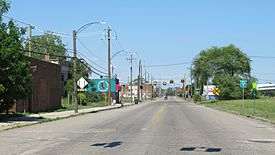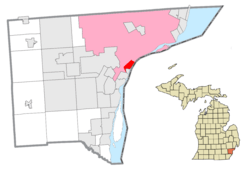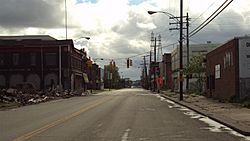Delray, Detroit facts for kids
Quick facts for kids
Delray
|
|
|---|---|
|
Neighborhood of Detroit
|
|

Looking north along W. Jefferson Avenue
|
|

Location of Delray (red) within the city of Detroit (pink) in Wayne County
|
|
| Country | United States |
| State | Michigan |
| County | Wayne |
| City | Detroit |
| Platted | 1836 |
| Incorporated | 1897 (village) |
| Annexed by Detroit | 1906 |
| Area | |
| • Land | 2.938 sq mi (7.61 km2) |
| Elevation | 591 ft (180 m) |
| Population
(2010)
|
|
| • Total | 2,783 |
| • Density | 947.2/sq mi (365.7/km2) |
| Time zone | UTC-5 (EST) |
| • Summer (DST) | UTC-4 (EDT) |
| ZIP code(s) |
48209 (Detroit)
|
| Area code(s) | 313 |
| GNIS feature ID | 1617006 |
Delray is a neighborhood in southwest Detroit, Michigan. It is located where the River Rouge meets the Detroit River. Delray was first mapped out in 1836. It started as a quiet, rural area.
In the 1890s, big factories started to move in. This brought a lot of jobs and money to Delray. It became an official village in 1897. Many immigrants from Eastern Europe came to live and work there. By 1906, Delray became part of the city of Detroit.
Delray's population grew to about 24,000 people by 1930. But after World War II, the number of residents started to drop. This was due to more factories, pollution, and buildings falling apart. By the 1960s, the city planned for Delray to be mostly industrial. In 2007, one newspaper called Delray "the closest thing to a ghost town within a city."
In 2013, Delray was chosen as the site for the new Gordie Howe International Bridge. This huge project is changing the neighborhood a lot. Many buildings and roads are being removed. Some residents have also had to move to new homes.
Contents
Where is Delray Located?
Delray does not have official borders. However, the Detroit Free Press describes its limits. It is bordered by the River Rouge to the south. The Detroit River is to the east. Fort Street is to the west, and Clark Street is to the north.
Delray is one of the southernmost neighborhoods in Detroit. It is next to the city of River Rouge. The main roads through Delray are West Fort Street, Interstate 75, and West Jefferson Avenue.
Delray's Story: From Village to Bridge Site
The area that is now Delray was first mapped in 1836. It was called Belgrade. Fort Wayne was built in 1843. It was a fort on the Detroit River. The area was renamed "Del Rey" in 1851. This name came from a Mexican–American War veteran. He remembered a village in Mexico called Molino del Rey. The name was later changed to "Delray." It got its own post office in 1870.
In 1889, Delray hosted the Detroit International Exposition. This was a big fair to show off Detroit's growing economy. The fair's main building was huge. It had 200,000 square feet of space. The fair was very popular at first. But attendance dropped, and it ended in 1894.
The Rise of Industry
In 1895, Delray became a center for heavy industry. The Solvay Process Company opened a chemical plant. Other large factories followed. These included iron and steel companies. Many of these factories were on Zug Island, just across the River Rouge.
By 1900, Delray attracted many immigrants from Eastern Europe. They came for the job opportunities. Many Hungarian immigrants settled here. By 1911, about 5,000 Hungarians lived in Delray. Newspapers often wrote about the crowded homes and many saloons in the area.
Detroit officially took over Delray on April 1, 1906. This added 20,000 people to the city. Detroit quickly worked to improve the area. Delray had only one paved street at the time.
Growth and Decline
In the 1920s, Delray's factories continued to grow. Fisher Body opened a car body factory in 1922. The Detroit Union Produce Terminal opened in 1929. It was a large food distribution center. The Ford River Rouge Complex was completed nearby in 1928. It employed 85,000 workers at its busiest.
By 1930, Delray's population reached about 24,000. But after 1940, the population started to fall. Many residents moved to the suburbs. This was a common trend across the country. More factories and new roads like Interstate 75 led to homes being torn down.
By the late 1960s, Delray faced many challenges. It had fewer people, rundown buildings, and a lot of pollution. The city decided Delray should become purely industrial. Residents were upset and even held a mock funeral for the neighborhood in 1975. This was to draw attention to the problems. The General Motors Fleetwood plant closed in 1987. This meant over 3,000 jobs were lost.
By 2000, only about 3,100 people lived in Delray. The Great Recession caused more businesses to close. A journalist noted in 2009 that a "foul stench" was still present. This was due to the wastewater plant and remaining factories.
The Gordie Howe International Bridge
In 2013, Delray was chosen for the Gordie Howe International Bridge. This bridge will create a second crossing between the United States and Canada. Building the bridge has meant tearing down many houses and streets. The city has a program to help affected residents move to new homes. In 2021, the U.S. and Canadian governments called the bridge a "top infrastructure project."
Delray's Hungarian Community
In the early 1900s, the Delray area was known as "Little Hungary." It was the center of Hungarian culture in Michigan. Hungarian immigrants came to Delray for better jobs and pay. Many were escaping political problems in the Austro-Hungarian Empire.
In 1905, the Holy Cross Hungarian Roman Catholic Church opened in Delray. By 1911, about 5,000 Hungarians lived there. After World War I, more Hungarian refugees arrived. They came due to religious and political reasons. They chose Detroit because car factories paid good wages. A new, larger Holy Cross Hungarian Church opened in 1925.
In 1935, a writer named Doanne Erdmann Beynon studied the Hungarian community. He noted that Hungarians from different parts of Hungary lived together. They created a new, shared Hungarian way of life in Delray. They formed many social clubs. These included athletic, singing, and insurance groups. Many Hungarians in Delray stayed within their community. Some who had lived in Detroit for 15-20 years had never even visited the city center.
After World War II and the Hungarian Revolution of 1956, more Hungarians came to Delray. However, the building of Interstate 75 in the 1960s split the community. Many Hungarians moved to nearby suburbs like Allen Park and Lincoln Park. The Holy Cross parish school also closed. The Holy Cross Hungarian Church celebrated its 75th anniversary in 2000.
Learning in Delray
Public Schools
Students in Delray attend Detroit Public Schools (DPS). Clemente Elementary serves the neighborhood for younger students. All high school students attend Western International High School.
Past Schools in Delray
James McMillan School was in central Delray from 1894 to 1999. It started as an elementary school. It was later a high school, then back to an elementary school. DPS closed it in 1999. The building was vandalized and had fires. It was torn down in 2009. Cary Elementary School is also in the neighborhood but is now abandoned.
Public Libraries
The Detroit Public Library opened a branch in Delray in 1907. This was replaced by the James Valentine Campbell Branch in 1922. This branch closed in 1996. A smaller Campbell Annex Branch opened later. It closed in 2004. The closest library now is the Campbell Branch Library. It is located outside Delray in the Springwells neighborhood.
Images for kids
-
Interstate 75 was built over several blocks of Delray.
-
Zug Island (River Rouge) as seen from West Jefferson in Delray









